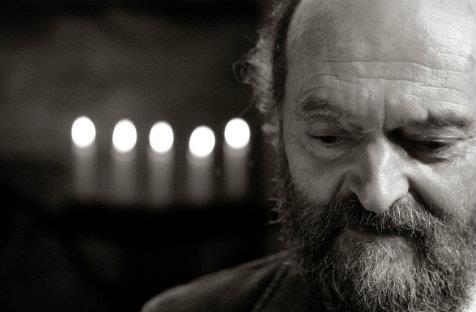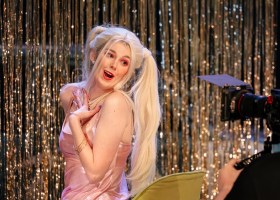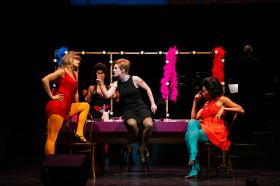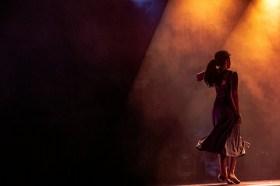Clearly the Concert Hall of the Sydney Opera House is in desperate need of a refurbish, or at least a new shampoo, for there was a serious amount of dandruff falling onto the stage.
One is, of course, being somewhat facetious, as the ‘dandruff’ was meant to be a delicate dusting of snow, but the image bounced around my head as I was listening to the music, and it didn’t leave.
It was a curious concert, this – Arvo Pärt: A Sacred Journey. It was part of the Sydney Opera House’s ‘The Composers’ series, where they choose a composer each year to ‘celebrate and champion the very best and most interesting music of our time’. Arvo Pärt is the second composer to be chosen, with Steve Reich the first – a choice that, last year, resulted in one of this critic’s musical highlights, with a day that began in the Utzon Room in an interesting – though not brilliant – concert, then ended late in the evening after a mammoth four-hour-plus program in the Concert Hall, with Steve Reich himself performing in one of the pieces. This year, everything was a bit more subdued, a bit shorter, and a tad weirder. And Arvo Pärt, if he was present, didn’t make himself known.
We started with all the lights going down, which no doubt perturbed some of the people still shuffling down the rows to their seats. And this was to set the pattern for the rest of the evening, whereby the audience was not allowed to read their programs in between pieces. (Apparently we should have known beforehand to memorise the order of music.) And it would seem that whoever designed the lighting sat down and thought to themselves not only ‘how best can we make this difficult for the audience?’, but ‘how can we make this more of a challenge for the stage technicians?’ One must admit, for instance, that there was a certain sense of danger – a sense of circus, even – to watching them roll a piano to the side, the precipice, of the stage in near darkness. The explanation for all of this is contained in one word: ‘atmosphere’. It was a ‘sacred journey’, after all. But when half the audience claps a stage hand – thinking he’s the conductor – then you know you’re perhaps taking things a tad too far. Still, the darkness did help one focus somewhat more earnestly on the pieces, so it wasn’t completely horrible.
The first piece, Magnificat, was for the Estonian Philharmonic Chamber Choir. (Arvo Part is Estonian, too.) Conducted by Tonu Kaljuste, and amplified through five or six microphones positioned along their length – as they were for the rest of the night – they proved themselves to be a superb ensemble, with a tight control over dynamics (something that’s very important, especially, in choral music, lest a piece blends together into a series of averages) and careful attention to detail.
The Concert Hall was darkened – as mentioned before – with only a series of lights on the choir and conductor, but above it all was a large screen, hanging above the acoustic rings. It was made of a gauzy, see-through like substance, and two projectors were aimed at it, both projecting the same image. Here it was a stained glass window, depicting a religious setting, and the effect of the two projectors was to double (and overlap) the image onto the grand organ behind the screen. Very beautiful, very lovely.
The next piece was Spiegel im Spiegel, a frustrating prolongation for violin (Helena Rathbone, from the Australian Chamber Orchestra) and piano (Tamara Anna Cislowska). It consisted of very slow notes on the violin, accompanied by patterings on the piano, and was impeccably and delicately beautiful and haunting. But, going for what felt like 10 or 15 minutes, this critic found the length resisted concentration, even with the projections of snow on the screen, and even with, in the latter sections of the piece, the dandruff falling from the heights and into Rathbone’s spotlight. (It also landed on the conductor’s podium, but no one bothered to clean if off until the interval.) It was all very theatrical, all very lovely, but it overstayed its welcome, like a monk who, while not eating any of your food, won’t stop meditating in your backyard.
7 Magnificat Antiphons, with the Choir once more, came next, and, consisting of seven quite short pieces, made for a rather lovely contrast. (Stained glass was the name of the game on the screen for this one again, even if it was a different picture.)
Tabula rasa finished the first half. It is a double violin concerto, which, presumably because no one could read their programs – not that it was particularly highlighted unless one read through the wall of text that was the program notes for the entire concert – had two movements. As such, after the first, the audience, duly impressed (as was this critic), burst out with a generous applause that had to be silenced by the conductor so that the piece might continue.
The first movement is the highlight, with Kirsty Hilton and Veronique Serret (the two violins) out in front of members of the Sydney Symphony (basically a quite sizable subsection of the strings). It depicts a constant restarting from the drawing board, an ever-increasing periodic swelling of frenetic activity – interspersed with moments of tired silence – that eventually breaks into joyous movement. It was brilliant. The second movement, structured like a canon, was the slow portion of the piece, and beautiful as it was, suffered like Spiegel im Spiegel before it. (It should be noted, however, that this critic is perfectly willing to admit that he may be less inclined to such prolonged moments than others, so adjust your reaction, dear reader, accordingly.)
Interval came, the stage was cleaned, and the second half began with Fratres, a piece for eight cellos in a semi circle. (I assume the score doesn’t specify that it be a semi circle, but that is how they were positioned.) This was a much more satisfying slower work, with the eight cellos oscillating between dissonances and quasi-harmonies shifting in and out of existence, and the occasional percussive moments that start the cycle again. Also of note was the amount of trouble the musicians had with keeping their music on their stands – it would seem that someone had the air conditioning pointed in the wrong direction. (Helena Rathbone’s blue dress, for instance, looked as if it were in front of a wind machine, gently billowing around her.)
Salve Regina followed, with the Choir and the Symphony, and was glorious in its instrumental complications and vocal power. Cantus in Memory of Benjamin Britten was rather brief – compared to the rest of the program – but was no weaker for it, with its bell tolling throughout the crescendo of the orchestra.
The concert ended with Adam’s Lament, which felt like a less concentrated version of Salve Regina, allowing for some more diluted and exploratory parts, though still retaining a nice control over its admittedly freer structure. One isn’t entirely sure what it is that Adam – presumably the biblical figure, considering the text was written by a monk – is lamenting, as the program doesn’t bother to tell us. (I feel I should mention the word ‘tintinnabuli’, however, because it appears rather frequently throughout the program notes. Almost as if it were ringing in the mind’s ear.) Perhaps he’s longing for a partner. Perhaps he’s depressed about being expulsed from Eden. Perhaps he was stung by a bee – we’ll never know. But he’s certainly sad about it, and he’s certainly passionate about his sadness, and it makes for good listening.
The concert as a whole, in this critic’s opinion, wasn’t quite as good as the Steve Reich concert last year (though this is not because it only went for a mere two and a half hours), having a few more moments of tedium than one would’ve liked. (Pärt, like Reich, has a fondness for repetitiveness, though one could perhaps describe Part as Reich-without-a-morning-coffee (or vice versa). But it was certainly an occasion, and a grand one at that, and considering that it only takes one brilliant piece to make a concert worthwhile, and this had at least four brilliant moments in it, one couldn’t help but leave the Concert Hall entirely fulfilled.
Rating: 4 ½ stars out of 5
The Composers: Arvo Pärt – A Sacred Journey
Conductor: Tonu Kaljuste
Estonian Philharmonic Choir
Musicians of the Sydney Symphony
With Helena Rathbone (violin), Kirsty Hilton (violin), Veronique Serret (violin), Tamara Anna Cislowska (piano)
Arvo Part – Magnificat (1989)
Arvo Part – Spiegel im Spiegel (1978)
Arvo Part – 7 Magnificat Antiphons (1991)
Arvo Part – Tabula rasa (1977)
Arvo Part – Fratres (1982)
Arvo Part – Salve Regina (2011)
Arvo Part – Cantus in Memory of Benjamin Britten (1989)
Arvo Part – Adam’s Lament (2009)
Concert Hall, Sydney Opera House
7 April






